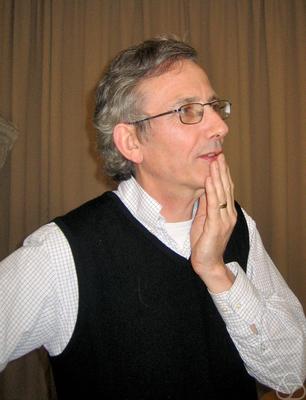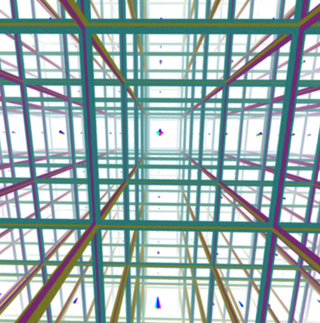External links
| International | |
|---|---|
| National | |
| Academics | |
| Other | |
| | This article about an American mathematician is a stub. You can help Wikipedia by expanding it. |
Robert Ernest Gompf (born 1957) is an American mathematician specializing in geometric topology.
Gompf received a Ph.D. in 1984 from the University of California, Berkeley under the supervision of Robion Kirby (An invariant for Casson handles, disks and knot concordants). [1] He is now a professor at the University of Texas at Austin.
His research concerns the topology of 4-manifolds. In 1990, he demonstrated with Tomasz Mrowka that there is a simply connected irreducible 4-manifold that admits no complex structures. In 1995, he constructed new examples of simply connected compact symplectic 4-manifolds that are not homeomorphic or diffeomorphic to complex manifolds (Kähler manifolds).
He is a fellow of the American Mathematical Society. [2] He was an invited speaker at the International Congress of Mathematicians in 1994 in Zurich (Smooth four-manifolds and symplectic topology).

In mathematics, low-dimensional topology is the branch of topology that studies manifolds, or more generally topological spaces, of four or fewer dimensions. Representative topics are the structure theory of 3-manifolds and 4-manifolds, knot theory, and braid groups. This can be regarded as a part of geometric topology. It may also be used to refer to the study of topological spaces of dimension 1, though this is more typically considered part of continuum theory.

Sir Simon Kirwan Donaldson is an English mathematician known for his work on the topology of smooth (differentiable) four-dimensional manifolds, Donaldson–Thomas theory, and his contributions to Kähler geometry. He is currently a permanent member of the Simons Center for Geometry and Physics at Stony Brook University in New York, and a Professor in Pure Mathematics at Imperial College London.

In mathematics, a 3-manifold is a topological space that locally looks like a three-dimensional Euclidean space. A 3-manifold can be thought of as a possible shape of the universe. Just as a sphere looks like a plane to a small enough observer, all 3-manifolds look like our universe does to a small enough observer. This is made more precise in the definition below.
In an area of mathematics called differential topology, an exotic sphere is a differentiable manifold M that is homeomorphic but not diffeomorphic to the standard Euclidean n-sphere. That is, M is a sphere from the point of view of all its topological properties, but carrying a smooth structure that is not the familiar one.
In mathematics, the Property P conjecture is a statement about 3-manifolds obtained by Dehn surgery on a knot in the 3-sphere. A knot in the 3-sphere is said to have Property P if every 3-manifold obtained by performing (non-trivial) Dehn surgery on the knot is not simply-connected. The conjecture states that all knots, except the unknot, have Property P.
In mathematics, a 4-manifold is a 4-dimensional topological manifold. A smooth 4-manifold is a 4-manifold with a smooth structure. In dimension four, in marked contrast with lower dimensions, topological and smooth manifolds are quite different. There exist some topological 4-manifolds which admit no smooth structure, and even if there exists a smooth structure, it need not be unique.
In mathematics, Floer homology is a tool for studying symplectic geometry and low-dimensional topology. Floer homology is a novel invariant that arises as an infinite-dimensional analogue of finite-dimensional Morse homology. Andreas Floer introduced the first version of Floer homology, now called Lagrangian Floer homology, in his proof of the Arnold conjecture in symplectic geometry. Floer also developed a closely related theory for Lagrangian submanifolds of a symplectic manifold. A third construction, also due to Floer, associates homology groups to closed three-dimensional manifolds using the Yang–Mills functional. These constructions and their descendants play a fundamental role in current investigations into the topology of symplectic and contact manifolds as well as (smooth) three- and four-dimensional manifolds.
In mathematics, a Lefschetz pencil is a construction in algebraic geometry considered by Solomon Lefschetz, used to analyse the algebraic topology of an algebraic variety V.

Robion Cromwell Kirby is a Professor of Mathematics at the University of California, Berkeley who specializes in low-dimensional topology. Together with Laurent C. Siebenmann he developed the Kirby–Siebenmann invariant for classifying the piecewise linear structures on a topological manifold. He also proved the fundamental result on the Kirby calculus, a method for describing 3-manifolds and smooth 4-manifolds by surgery on framed links. Along with his significant mathematical contributions, he has over 50 doctoral students and his problem list.
Peter Benedict Kronheimer is a British mathematician, known for his work on gauge theory and its applications to 3- and 4-dimensional topology. He is William Caspar Graustein Professor of Mathematics at Harvard University and former chair of the mathematics department.
In mathematics, a smooth algebraic curve in the complex projective plane, of degree , has genus given by the genus–degree formula
In mathematics, specifically in symplectic geometry, the symplectic sum is a geometric modification on symplectic manifolds, which glues two given manifolds into a single new one. It is a symplectic version of connected summation along a submanifold, often called a fiber sum.

Clifford Henry Taubes is the William Petschek Professor of Mathematics at Harvard University and works in gauge field theory, differential geometry, and low-dimensional topology. His brother is the journalist Gary Taubes.
The Oswald Veblen Prize in Geometry is an award granted by the American Mathematical Society for notable research in geometry or topology. It was founded in 1961 in memory of Oswald Veblen. The Veblen Prize is now worth US$5000, and is awarded every three years.
John Willard Morgan is an American mathematician known for his contributions to topology and geometry. He is a Professor Emeritus at Columbia University and a member of the Simons Center for Geometry and Physics at Stony Brook University.
In topology, an Akbulut cork is a structure that is frequently used to show that in 4-dimensions, the smooth h-cobordism theorem fails. It was named after Turkish mathematician Selman Akbulut.

Tomasz Mrowka is an American mathematician specializing in differential geometry and gauge theory. He is the Singer Professor of Mathematics and former head of the Department of Mathematics at the Massachusetts Institute of Technology.

Yakov Matveevich Eliashberg is an American mathematician who was born in Leningrad, USSR.
Yongbin Ruan is a Chinese mathematician, specializing in algebraic geometry, differential geometry, and symplectic geometry with applications to string theory.
Ronald Alan Fintushel is an American mathematician, specializing in low-dimensional geometric topology and the mathematics of gauge theory.